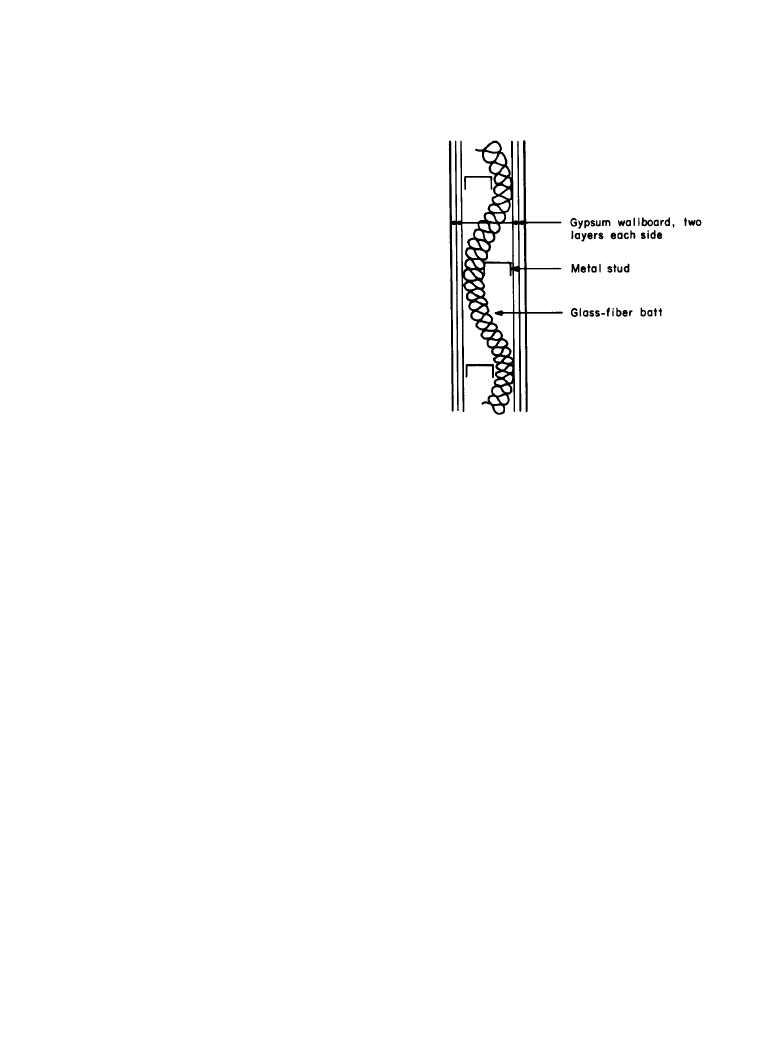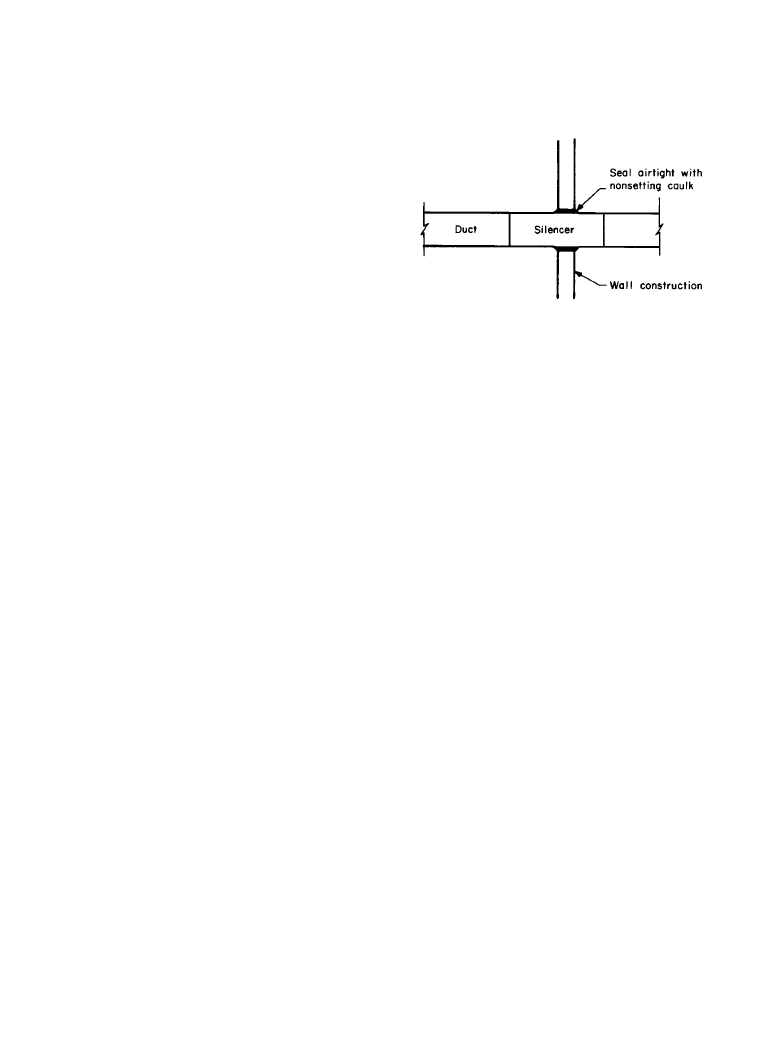ВУЗ: Казахская Национальная Академия Искусств им. Т. Жургенова
Категория: Книга
Дисциплина: Не указана
Добавлен: 03.02.2019
Просмотров: 21620
Скачиваний: 19

3-35
Chapter
3.3
Sound Isolation
Richard G. Cann, Anthony Hoover
3.3.1
Introduction
Sound may travel to an adjacent space by a multitude of paths. Obviously it can travel through
apertures. But if all these holes are sealed, the sound is ultimately received after vibrations have
been transmitted through the building structure. Because they travel readily in solid materials,
the vibrations may take long, devious paths before arrival. If high noise isolation is required, all
paths that the vibration may take need to be interrupted; there is little value in blocking one path
when a significant amount of the sound travels through a flanking path.
3.3.2
Sound Barriers
In most building applications involving audio systems a very sizable transmission loss is often
required. The performance of the single homogenous wall is inadequate; doubling the mass of
the wall gains only 6 dB. Often space or floor-loading restrictions also limit this option. Alterna-
tively, increased performance can be obtained from a two-wall system such as that shown in Fig-
ure 3.3.1, in which one wall is completely separated from the other, over its entire area, by an air
gap. Reverberant sound within the interior cavity is absorbed by fiberglass. The coincidence dip
is reduced by ensuring that the frequency at which it occurs is different for each wall.
Care must be taken not to inadvertently reduce the design transmission loss (TL) by tying the
two walls together with a mechanical connection, such as a wall bolt or perhaps a pipe. Also, care
must be taken with air leaks. Electrical outlet boxes on opposite sides of the wall must be stag-
gered by at least 3 ft. Conduit and pipes should pass through the wall at its perimeter. The joints
between the wall, ceiling, and floor must be grouted or caulked with an elastomeric compound.
Never use foam caulk for acoustical isolation. If an air duct must pass through the wall, special
arrangements must be made to ensure that sound does not travel into the duct wall, through the
wall, and back out through the duct wall into the adjoining space.
Downloaded from Digital Engineering Library @ McGraw-Hill (www.digitalengineeringlibrary.com)
Copyright © 2004 The McGraw-Hill Companies. All rights reserved.
Any use is subject to the Terms of Use as given at the website.
Source: Standard Handbook of Audio and Radio Engineering

3-36 Architectural Acoustic Principles and Design Techniques
3.3.2a
Partial Walls and Barriers
The effectiveness of sound barriers depends partly on the amount to which sound traveling over
the top or around the sides is diffracted. In practice, the effectiveness is limited, even under the
most favorable geometric layout, to about 25 dB. The material of construction does not influence
a barrier’s performance provided that its transmission loss is sufficient to block significant sound
from passing through. For many applications, 1/4-in plywood has sufficient mass and may be
used effectively, but other materials are often preferred because they meet other criteria such as
weatherability or structural strength.
Where barriers are also used in interior spaces, such as partitions, their performance is
degraded by the reflection and reverberation of sound from the adjacent walls and ceiling. In
many situations reverberant sound greatly exceeds the diffracted-sound level.
Where barriers fully or partially enclose a source, some additional performance can be gained
by reducing the local reverberant field by applying absorptive materials to the inside surface of
the partition and other adjacent surfaces.
3.3.2b
Doors
The door is potentially the limiting element in noise isolation for an interior wall. Not only may
the frame reduce the transmission loss of the mounting wall, but improper sealing of gaskets fur-
ther reduces performance. Furthermore, a good noise control design does not assume that gas-
kets will remain good after abuse by substantial traffic. Alternatively, a design with two well-
fitting ungasketed doors should be considered. A significant increase in performance can be
obtained by placing the doors a minimum of 4 in apart. Further improvements can be made by
increasing the separation between the two to form an air lock in which acoustically absorptive
materials are applied. The close-separation arrangement is awkward to use since the two doors
must open in opposite directions. The air-lock design may be more convenient, although it does
occupy more space.
Figure 3.3.1
Section of a lightweight double wall.
Downloaded from Digital Engineering Library @ McGraw-Hill (www.digitalengineeringlibrary.com)
Copyright © 2004 The McGraw-Hill Companies. All rights reserved.
Any use is subject to the Terms of Use as given at the website.
Sound Isolation

Sound Isolation 3-37
3.3.2c
Ceilings and Floors
Much of that which applies to walls also applies to ceiling and floor elements, but there are addi-
tional precautions to be taken. The addition of carpet to a floor does not decrease the airborne
sound transmitted to the space below. However, carpet does reduce the generation of impact
noise. Impacts on a hard floor from shoe heels and rumblings from steel-tired hand trucks are
readily discernible.
In renovations where it is often the preference to refinish old wooden floors, noise isolation is
difficult. The floorboards often have significant cracks, and if—in addition—no solid ceiling is
permitted below, the sound transmission loss may be unacceptable.
If the transmission loss of the floor structure is found to be inadequate, it can be increased by
applying a ceiling mounted to resilient channels, which in turn are fastened to the joists. Better
still, a complete lower ceiling may be supported by resilient hangers which penetrate the upper
ceiling to attach to the joists. It may be possible to use the cavity for air ducts as long as duct
breakout is not a problem. Otherwise additional noise isolation for the duct must be provided.
3.3.2d
Floating Rooms
Where maximum noise isolation is required and cost is of little concern, a room may be “floated”
within a building space on vibration isolation pads. All building services are supplied through
flexible connections. All doors are double, with the inner door and frame attached only to the
floating room. The cavity around the room and under the floor is filled with sound-absorptive
material. This type of construction is little used in commercial applications.
3.3.2e
Windows
Most window manufacturers can supply TL data on their products. These show that single-
glazed windows typically have much less transmission loss than walls, and if they represent more
than a small fraction of the wall area they are usually the controlling element when the composite
transmission loss of wall and window is calculated. Data also show that the coincidence dip
occurs in the midfrequency range, which could be of concern when controlling the compressor
whine of a jet engine. However, for glass in which a plastic damping layer is sandwiched between
two glass layers, the depth of the coincidence dip is reduced.
Thermal glazing, two glazings with an air space, is also commonly used. However. because
the panes are close together, cavity resonance restricts any improved performance. But when the
panes are separated by several inches and sound-absorptive material is applied around the cavity
perimeter, there is a marked improvement in performance.
The local building code may require that a window with a specified sound transmission class
(STC) be installed, but for noise control applications STC values are insufficient. The full spec-
tral data should be used in any computations.
3.3.2f
Duct Break-In Break-Out
Mechanical-system ductwork has the potential for reducing the overall transmission-loss integ-
rity of a partition as a result of sound in one space breaking in through the sides of the ductwork,
traveling through the duct, and breaking out of the ductwork into another room. Detailed calcula-
Downloaded from Digital Engineering Library @ McGraw-Hill (www.digitalengineeringlibrary.com)
Copyright © 2004 The McGraw-Hill Companies. All rights reserved.
Any use is subject to the Terms of Use as given at the website.
Sound Isolation

3-38 Architectural Acoustic Principles and Design Techniques
tions of this effect can be quite complicated, but the effect should be accounted for. The calcula-
tion procedure for duct break-in and break-out can be found in [1].
It is good practice to avoid running a duct through a partition which is common to two spaces
that require a high degree of sound isolation between them. It is generally advisable to run the
main branch of ductwork outside either room under consideration and branch ductwork from the
main duct into the appropriate rooms; then, to determine the resultant sound isolation, the maxi-
mum sound pressure level expected in one room should be converted to sound power level at the
point at which the ductwork serving that room begins. Then the attenuation provided by the duct-
work elements between the rooms may be calculated as described above, and the sound power
level may be converted to sound pressure level in the other room in question. If it is determined
that the resultant sound pressure level will be too high, attenuation devices can be provided in the
ductwork. For example, a silencer should be inserted into the ductwork in the manner shown in
Figure 3.3.2. Sometimes it is also advisable to box in the ductwork with a construction that con-
sists of several layers of gypsum wallboard to reduce the amount of sound which breaks into a
piece of ductwork. It is almost never sufficient to wrap the ductwork with fiberglass materials,
and it is rarely sufficient to wrap the ductwork with lead sheet or vinyl sheet.
3.3.2g
Site Selection
When building a new facility, it is worthwhile to evaluate in detail the suitability of the site itself
for ambient and interfering noise as well as for production and aesthetic requirements. The cost
of construction to meet the specified criteria may be much greater at one location than another.
For example, the interior noise might be dominated by ground vibration from an adjacent rail-
road yard. Breaking this vibration path can be very expensive.
An industrial site might appear to be an excellent location to avoid the complaints of neigh-
bors late at night, but the facility may not be usable if punch presses are installed next door. If jet
aircraft fly close by, special construction may be required to protect the facility from low-fre-
quency noise. Consequently, it is imperative to check with the local airport authority about flight
patterns that are likely with different prevailing winds.
Figure 3.3.2
Installation of a silencer
between two rooms.
Downloaded from Digital Engineering Library @ McGraw-Hill (www.digitalengineeringlibrary.com)
Copyright © 2004 The McGraw-Hill Companies. All rights reserved.
Any use is subject to the Terms of Use as given at the website.
Sound Isolation

Sound Isolation 3-39
3.3.3
Vibration
Excessive vibration can cause several problems for audio engineers, including reradiation of
vibration-induced noise from walls and direct vibration of microphone elements through mike
stands. There exist quite a variety of vibration sources, such as mechanical equipment, automo-
bile and truck traffic, and even pedestrian traffic within a building. Once vibration has entered
the building structure, it may be difficult to control, and this problem can be exaggerated by res-
onances found in all buildings, which commonly occur in the range of 5 to 25 Hz. Thus, it is
important to try to determine which sources of vibration may be problematical and to isolate
them before vibration enters the building structure.
3.3.3a
Driving Frequency
The driving frequency of the vibration source is the most important consideration in trying to
develop a vibration isolation system. It is not unusual for a source to have several driving fre-
quencies, but it is the lowest driving frequency that is of primary concern. The lowest driving fre-
quency of most electrical and mechanical equipment can be determined from the lowest
rotational or vibrational motion. For example, a fan that operates at 1200 rpm has a lowest driv-
ing frequency of 20 Hz (this same fan may have a harmonic at 200 Hz if the fan has 10 blades).
To isolate mechanical equipment, some sort of vibration isolation device is placed between all
the supports of the piece of equipment and the building structure, such as underneath each of
four legs. The vibration isolation elements generally consist of steel springs, some sort of resil-
ient material such as neoprene rubber, or a combination of the two. As the machine is installed, it
compresses the mounts by an amount known as the static deflection. When installation is com-
plete, it can also be seen to have its own natural frequency. The natural frequency can be thought
of as the frequency in hertz at which the machine would oscillate after it was deflected from rest.
For example, an automobile with poor shock absorbers (shock absorbers add damping to the
vibration isolation system) would continue to bounce up and down at a couple of hertz after it
had been driven through a pothole.
The frequency ratio f is defined by
(3.3.1)
Where:
f
d
= the driving frequency, Hz
f
n
= the natural frequency, Hz
The static deflection d and the frequency ratio f
r
are related in the simplest case by
(3.3.2a)
where d is deflection, in, or
(3.3.2b)
f
r
f
d
/f
n
=
d
9.8 f
r
/ f
d
(
)
2
=
d
250 f
r
/ f
d
(
)
2
=
Downloaded from Digital Engineering Library @ McGraw-Hill (www.digitalengineeringlibrary.com)
Copyright © 2004 The McGraw-Hill Companies. All rights reserved.
Any use is subject to the Terms of Use as given at the website.
Sound Isolation